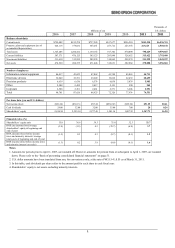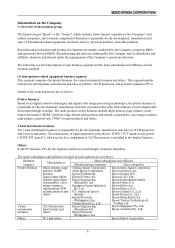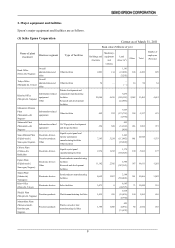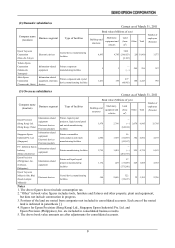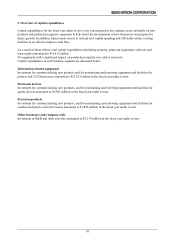Epson 2011 Annual Report Download - page 15
Download and view the complete annual report
Please find page 15 of the 2011 Epson annual report below. You can navigate through the pages in the report by either clicking on the pages listed below, or by using the keyword search tool below to find specific information within the annual report.
14
parties who supply ink cartridges that can be used in Epson printers. These alternative products are sold for less
than genuine Epson ink cartridges and, while they have relatively low market share in Japan and America, they
have high market share in certain Asian countries. To mitigate the risk that genuine ink cartridges could lose
market share, Epson will pursue a policy of earning sustained customer loyalty by emphasizing the quality of its
genuine products as well as by boosting user-friendliness, including by using even longer lasting ink and by
providing inkjet printers tailored to applications in each market. Epson will also take legal measures if any of the
patent rights or trademark rights it holds over its ink cartridges are infringed.
There is no assurance, however, that any of these efforts will be effective, and if Epson’ s net sales from
consumable products for inkjet printers declines because, for example, the market share of non-genuine ink
cartridges increases further or because genuine ink cartridges lose market share or Epson must reduce the prices
of Epson brand products, operating results might be adversely affected.
5. Market changes could affect Epson.
Epson is concentrating management resources on core businesses in which it can leverage its unique strengths –
printers, projectors, quartz devices and sensors – and on future growth areas as it seeks to strengthen its business
foundations, while at the same time also cultivating new businesses that will support the next generation.
However, because technological innovation and product cycles are changing extremely rapidly in markets where
Epson is focusing its managerial resources, the Company may be unable to respond flexibly to such changes and
develop and introduce competitive products. In addition, reduced consumption and capital expenditure in
Epson’s main markets stemming from economic downturns have hurt demand for Epson’s products in the past
and may do so in the future.
If, for example, Epson cannot suitably respond to technological innovations in its main markets, or if economic
downturns or other factors prevent a recovery in demand, Epson’s operating results could be adversely affected.
6. Trends in the electronic devices market could adversely affect Epson.
Certain trends reflect product life cycles and economic conditions in markets for electronic devices such as
semiconductors and mobile phone handsets. The electronics industry has historically been subject to large
cyclical fluctuations, and Epson has experienced a decline in demand for its products, excess production capacity,
and price erosion during downturns.
Epson has moved to put its electronic devices businesses in a stronger financial position, primarily through
restructuring, and make them more resistant to such market fluctuations. However, if product demand remains
sluggish for an extended period of time, or if the market deteriorates further, Epson’s operating results could be
adversely affected. There is also no assurance that Epson can always accurately predict future trends, and it is
possible that Epson might not be able to make the right investments at the right time in response to market
trends.
7. Epson competes with other companies.
Epson presently faces competition from powerful companies with abundant financial resources or strong
financial compositions, and from companies in such countries and regions as Taiwan, Korea, or China that have
the ability to manufacture competitive products or compete on price in Epson’ s markets. This competition could
adversely affect Epson’ s operating results.
In addition to such competition, there is also the possibility that powerful companies against which Epson does
not currently compete may use their brand power, technological strength, ability to procure funds, marketing
power, sales skills or low-cost production ability to newly enter a business area of Epson’ s and compete with it.
8. Expanding businesses overseas entails risks for Epson.
Epson is continuing to expand its businesses overseas; more than 60% of its consolidated sales for the business
year ended March 2011 were overseas sales. Epson has production sites all over Asia, including China,
Indonesia, Singapore, Malaysia and the Philippines, as well as in the United States, the United Kingdom, and
other countries. It has also established many sales companies all over the world. As of March 2011, overseas
employees account for more than 70% of Epson's total workforce.
Epson believes that its global presence provides many advantages. For example, it enables Epson to undertake
marketing activities aligned with the market needs of individual regions and leads to greater
cost-competitiveness by reducing production costs and lead times. There are, however, unavoidable risks


